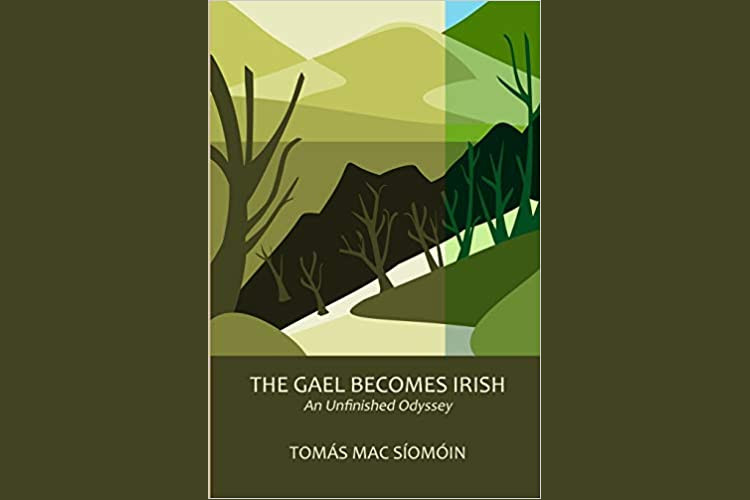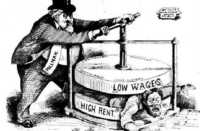■Tomás Mac Síomóin, The Gael Becomes Irish: An Unfinished Odyssey (Nuascéalta, 2020)
It is difficult to imagine a deeper enslavement of a subject people than to deprive them of their language. Such a condition has a deep psychological effect, which causes the abnormal to seem normal. There is a pretence that it doesn’t matter, or it happened so long ago as to be immaterial, or even that it didn’t occur at all.
In the Irish situation it is believed that the language shift happened many centuries ago and had something to do with some deficiency in Irish as a vernacular. How many are aware that at the beginning of the nineteenth century Irish was the daily language of the majority of the nation and for a substantial number was their only language?
We are left with a peculiar concept of what it means to be Irish: we are great craic, we drink like mad, we are convinced we are the most friendly people in the world and the most loved, and haven’t we great leipreachán hats, especially on St Patrick’s Day?
This isn’t just pub talk but runs deep in what passes for serious commentary. We manage to match such a weak nationality with a strong nationalism. There are even Irish people who regard the loss of the language as something to be celebrated. This deep psychological capitulation to a colonised oblivious mentality belies an incapability to imagine a culture-changing liberation.
The disastrous effects of cultural, intellectual, economic and political colonisation and the dominant ideology of present-day Ireland is at the core of a book by Tomás Mac Síomóin, The Gael Becomes Irish: An Unfinished Odyssey. Dr Mac Síomóin, though resident in Catalonia for twenty years, is arguably the most creative writer in Irish today. He is not a literary seclusionist or an isolated theorist but has been a lifelong political activist (including some years on the National Executive Committee of the CPI) and is an astute observer of minds and mores.
He delineates the genocidal brutality of the colonial occupiers throughout early modern history. From the middle of the eighteenth century the occupation had an enthusiastic coterie of collaborators in the emerging Catholic middle class. The development of capitalism and increasing cultural assimilation went hand in hand with the rise and enrichment of this class. By the early twentieth century Redmond led the Irish bourgeoisie to push for a place in the imperialist sun. A deep Redmondism informs the policies of the Irish state today and is not confined to the crassness of the likes of the Tan Flanagan.
After the disaster of Culloden the Catholic church changed its allegiance from the Jacobites to the monarchical patrons of the Penal Laws. Henceforth it played a huge part in undermining the use of Irish. Maynooth College (founded in 1791), a collaborative enterprise of the imperial government and the Catholic hierarchy, strengthened the dominance of both parties and had a calamitous linguistic effect. The most influential Irish politician of the next generation, Daniel O’Connell, was an enthusiastic angliciser who openly welcomed the demolition of Irish as the majority vernacular.
From 1922 onwards the dominant counter-revolutionary circles were happy to adopt the symbolic use of Irish but did nothing concrete to promote the language or even facilitate its use in the Gaeltacht. As Mac Síomóin points out, Irish society suffers from an inherited inferiority in relation to the language, which expels it to the margins of life, to being a pastime, a folkloric detail, and a nice bit of bunting for special occasions.
The author draws on the work of the Portuguese scholar Boaventura de Sousa Santos, who holds that forced cultural assimilation confronts all those societies and collectives whose knowledge, bases and forms of living are denied and disqualified: women, black people, LGBT communities, and other marginalised and colonised groups, and treats them with what he calls “epistemic injustice.” Speakers of minority languages come within the scope of de Sousa’s frame of reference.
Tomás Mac Síomóin goes on to broaden the language issue to other questions that are not being addressed by the commentariat or society in general. As a scientist he fears “the inexorable drift of environmental data towards human extinction.” He is concerned that mainstream media are coming to be “subverted to the task of law and order maintenance . . . Methods of repression,” he continues, “associated traditionally with totalitarian states, are almost certainly to be introduced in the interests of ‘security’.”
Mac Síomóin worries that the “new evolving normality could very well usher in a not very attractive dystopian technological world: a fractured society,” distinguished by a high rate of unemployment, “galloping robotisation” and increased social inequality “and sustained by basic income, readily available ‘recreational’ opioid drugs, together with cheap or free mass entertainment.”
The book reproduces an interview with the Kenyan Marxist writer and activist Ngũgĩ wa Thiong’o, first published in An Phoblacht (no. 3, 2019). Ngũgĩ says: “. . . systems of conquest, colonialisation and domination go for the linguistic jugular. So national liberation must, of necessity involve at the very least a recovery of a people’s linguistic base.”
That puts the issue raised by Dr Mac Síomóin in a nutshell. The cultural struggle is not an optional appendix to the liberationist agenda, and it is not a specifically Irish question.






